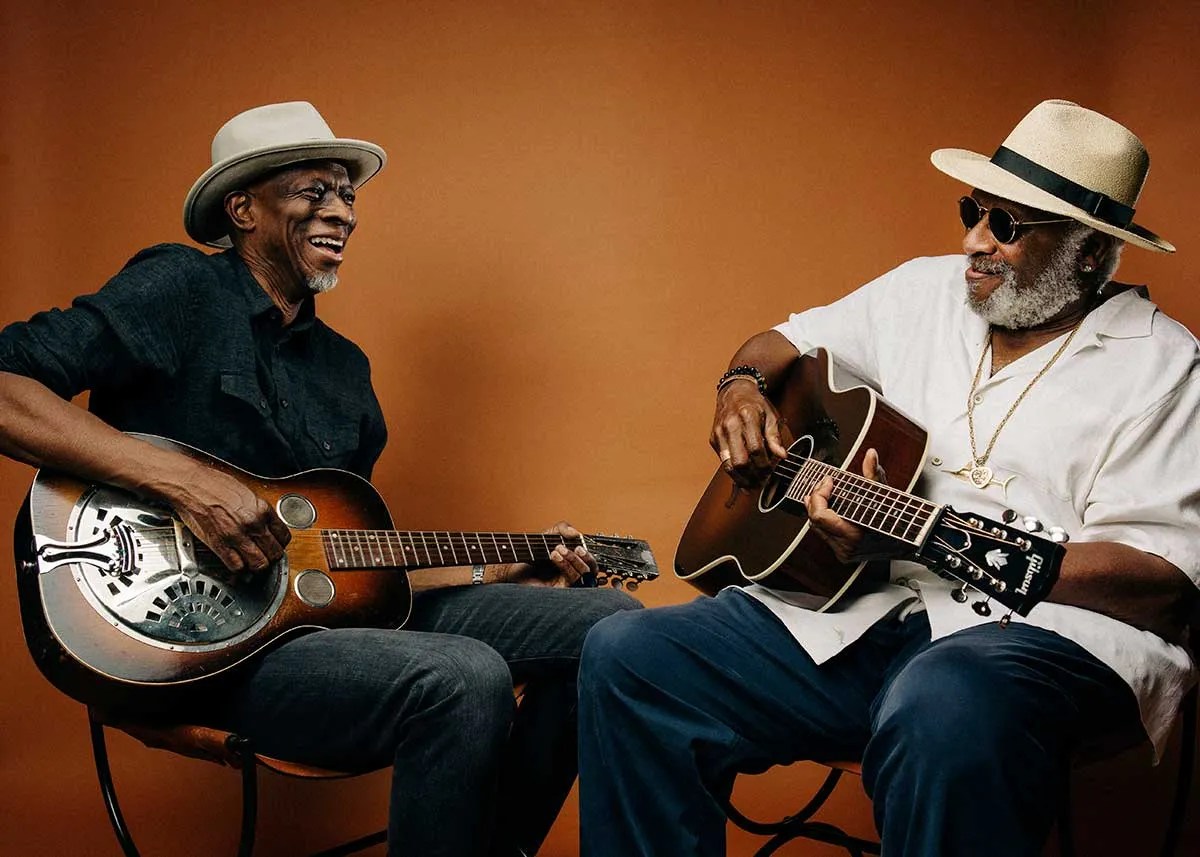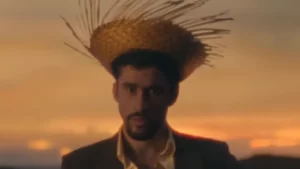
Taj Mahal and Keb’ Mo’ Reunite to Channel Tradition, Tone, and Spirit into a Sound All Their Own
It’s been a busy eight years since Taj Mahal and Keb’ Mo’ released TajMo, their first collaborative project. Blessed with a track list that highlighted the natural chemistry between the artists born Henry St. Claire Fredericks Jr. and Kevin Roosevelt Moore—as well as a guest list that boasted Sheila E., Lizz Wright, Joe Walsh, and Bonnie Raitt—TajMo picked up the 2018 Grammy for Best Contemporary Blues Album and inspired a joint tour that took the pair across the U.S. and Europe. Since then, both artists have stayed on the road, each racking up more Grammys (Mo’ for 2019’s Oklahoma, Mahal for his 2022 Ry Cooder collab, Get on Board, and this year’s Swinging Live at the Church in Tulsa) while continuing to deepen their already impressive discographies.
Now Room on the Porch, co-produced by Mo’ and Mahal, builds on their distinctive brand of easygoing, Afro-diasporic synergy. Featuring wistful ruminations like the title track, love songs (“Better Than Ever,” “She Keeps Me Moving,” “My Darling My Dear”), jams (“Junkyard Dog,” “Thicker than Mud,” “Make Up Your Mind”), and classics (“Nobody Knows You When You’re Down and Out”), Room aims to prove, as one song asserts, that the “Blues’ll Give You Back Your Soul.” It also brings back TajMo contributor Colin Linden (mandolin and guitar) and showcases singer-songwriter Ruby Amanfu, Mahal’s son Ahmen Mahal, and Moore’s son K. Roosevelt. The 11-track album ends with the acoustic duet “Rough Time Blues,” a meditation that perfectly fits this moment in history.
For our wide-ranging interview, Keb’ Mo’, 73, joined us from his home outside Nashville while 83-year-old Mahal signed on from somewhere on the road. The vibe was a frequently funny call and response between Mo’ and his humble baritone and Mahal’s gravelly, cosmic perspectives. (When Mo’ mentioned that his computer “exploded a little bit,” Mahal hilariously invoked his own 1968 chestnut: “Oh, no! She caught the katy!”)
“What we do is give people an alternative to the BS that’s out there,” says Mahal. “You want to relax? You want some peace? You want your thoughts to yourself? Come over here,” he adds, laughing. “This music has always been our salvation, and we gave it up to the beast. The beast don’t care, so let’s stay where we are.”
Room on the Porch is like a message from the ancestors and a dispatch from the future. It’s both optimistic and grounded.
Keb’ Mo’ and Taj Mahal, Photo: David McClisterMahal: Thank you! That’s always the way I’ve seen the blues, and that’s why 25 years ago, I finally recorded with an eight-piece Malian band [on 1999’s Kulanjan, with Toumani Diabaté] that went beyond the 500 years of us being in America and connected me with my ancestral relatives who play music. That stuff is powerful! You go back to where they are, and you bring them forward to where you are. The West African musicians are so powerful because they’ve been here since the 11th century, unbroken by anybody from the outside. No commercial, no corporate, no platform has broken into their consciousness or their power. It’s not the law of diminishing returns.
You’ve both explored many different sounds in your careers. What does this collaboration inspire?
Mo’: We are Taj Mahal and Keb’ Mo’, but together, we become a third entity. That entity becomes the partnership. The sum of the parts is greater than the whole.
Mahal: Exactly. And the listener is the one that gets a whole lot. As much as we hear, you hear something different.
Mo’: That’s right!
Mahal: When Robert Johnson was listening to Son House, Willie Brown, and Charlie Patton, he was right at the vortex. He could grab something from here and something from there, and it didn’t have to be in a straight line, but it all felt connected because it was coming through him.
Do you feel that your collaboration was preordained?
Mahal: The two of us know that this is supposed to happen. We’ve been chosen, and this is our job. It comes through us, and it’s exciting that after all the work we did separately, we finally came together. Keb’ heard me when he was 17 years old, in high school, and it took us nearly 20 years to finally meet.
How does it feel to work with someone you idolize?
Mo’: I’m in a constant state of disbelief.
Mahal: Really? You better come on down to earth! [laughter]
Mo’: I’m baffled by how a series of incidents can lead to something as grand as this, how it can be choreographed and orchestrated. ’Cause it didn’t have to happen.
Mahal: That’s right. But see, that’s when you know that it’s ancestor involvement.
Mo’: Yeah!
Mahal: Most people are really disappointed when they meet people [they look up to] and find out that they really are not the people they expected. But I’ve always been this person. You go back and talk to all my partners that I grew up with, and they’ll tell you, “Man, that’s the same guy he was back then”—even if I’m a little bit older and moving a little bit slower.
Mo’: You can’t be idolized in your hometown [laughter]. I just came back from Compton [California, Keb’ Mo’s birthplace], and, you know, it puts you right back. They set you right back where you’re supposed to be.
Mahal: Yeah, man! As far as the two of us, Keb’ saw me at two concerts when he was in high school, and more than likely I saw him when he was playing with Papa John Creach. On the streets, I was hearing, “Keb’ Mo,’ Keb’ Mo’—you heard Keb’ Mo’ yet? He’s a brother and he plays acoustic guitar!” People were saying that he reminded them of me. In the old days, it used to be, “Richie Havens and the other guy,” or “Taj Mahal and the other guy.” [laughter]
Were you looking for collaborators?
Mahal: For 25 years I was looking for people to really work with. We met through a mutual friend, he came down to a session in ’93, and from there it jumped off. I made doggone sure that when we’re out here, we’re going to do stuff together. Like he said, the sum of the parts. It’s serendipitous, and it’s everything. I’m really thrilled that we can create some music that’s going to move you, no matter who or where you are.
What’s the collaboration like?
Mahal: He brings so much to the table. I have one way of presenting myself, and he has a different way. I’m glad to be learning how it’s done. And when it goes through his vision and you see what comes out, on both the first album and the second TajMo album—wow!
Keb’ Mo’ and Taj Mahal, Photo: David McClisterHow do the two of you write together?
Mo’: We follow the other one’s lead. We have a trust between us, a creative trust. I know that whatever comes out of Taj is going to be righteous.
Mahal: And it works the same way with Keb’. He put me on a different game in this process of making music, because there’s a lot of different ways of getting there. But the music and the song and the magic decide a lot of direction.
Give me an example.
Mahal: “Room on the Porch” was a little guitar thing I used to play at night when I went back to my hotel room after shows. In quiet moments, I’d pick up my instrument and hear that song coming into my head; I’d tune my instrument, sit there, and play it. It’s been in the oven for about 20 years, so I knew it was time for it to come out. When I presented it, Keb’ knew right away who should come in and be involved in the writing, and here we are.
Mo’: Ruby [Amanfu] came in, heard it in a deeper way, snatched the ball, and ran. She led the charge and we followed her. We all wrote the song; it was just an innocent energy. You put the people in the room and then you let the spirit move, and you get out the way.
Mahal: That’s the first order of business: Learning how to get out of your own way and let the music speak. Because as much as the music has come through us, a lot of what we did musically came from us trying to make an adjustment.
How so?
Mahal: My grandmother was from the Caribbean, and she put me on her knee when I was three or four years old. She would say, “’Cause the wicked carry us away from captivity/ Required from us a song/ How can we sing King Alpha song in a strange land?” Before I heard the Melodians do it on The Harder They Come, that was something that people used to say to one another.
This is something we have to do. We can spend years trying to figure out what our music is and how to express ourselves, but this is beyond that. When you plug into [the ancestors], it’s like, “Yes. Mmm-hmm!” That’s the way it is.
It’s medicine for this moment.
Mahal: It needs to be, now, when things are real hard. I saw a link the other day where this woman was asking why Black farmers aren’t complaining about not getting any subsidies. The other farmers are like, “Oh my God, we’re going to lose our money,” but even though money came to the Black farmers’ area, it never got to them. We’ve always had to work without. The money didn’t come to the Black farmers, so they don’t have a dog in that fight. We didn’t have [lots of resources], but we had to make it work. And right now, we’re making it work for everybody. We’re leading the charge.
Some folks’ blues have more technique than soul, but you manage to make it sound round, fresh, and full. What’s the secret?
Mo’: Taj has an expression that goes something like, “Don’t chew all the flavor out of it.”
Mahal: They can’t chew all the flavor out of the blues. [laughter]
Mo’: You have to go back and listen to the masters, to the origins of the blues. I heard the blues when I was 10, 11, 12—way before I started trying to play it—and what I heard was the blues from the 1950s and ’60s. But when you go back to the ’20s, ’30s, the prewar ’40s, when you hear early Muddy Waters, Howlin’ Wolf, and Charley Patton, when you hear people like Mance Lipscomb and Bill Broonzy, who brought the blues up to Chicago from Mississippi—
Mahal: Yeah!
Mo’: —they are the blueprint. You know what to do after you’ve heard them.
How would you describe the sound of the blues?
Mo’: It’s that mixture of the blues and the church, and the conflict between them. They’re actually the same thing. In fact, when you go back far enough, country music sounds just like the blues.
Mahal: Well, that’s what it is!
Mo’: It’s all country. Country, gospel, and the blues. You see an old white guy playing country, and it’s like, “Wait a minute. That sounds like…” [laughter]
Mahal: The form is right there: I–IV–V.
Mo’: It was in the air, and then the city came in. When you add people’s problems, the music starts going in different directions, like, country, blues, R&B, rock, soul, and rock ’n’ roll, and it starts changing up. But when you go back to that fundamental, boy—it’ll sit you down and make you take notice.
National resonator, Keb’ Mo’ with Gibson Bluesmaster, and Taj Mahal with Kala ukulele – Photo: David McClisterAnd then there’s the music business.
Mahal: The corporate music industry doesn’t take time to bring out the roots unless it’s got a dollar sign attached to it, they’re in control, and they own the copyright. Unless you visit the Smithsonian or the Library of Congress and you know how to look for it, you can’t find it. There’s a delivery system, a machine, that makes sure you get [hip-hop], but this is over here. We’re serious about it.
Mo’: When I was on Sony in the ’90s, I realized that these companies were doing something magical that they probably didn’t even realize: They were preserving history. While they were trying to monetize this old music, they were spreading and enhancing the culture; everything about all of it is still there. The music might make them a little money, but it doesn’t even compare to what happens when people hear that music.
Mahal: Right! That’s where I think our job is—to make sure that when the young people come looking, we got something for them. I hear people saying that this record is like new music to them. Like you said, round, fresh, and full. Somewhere to go that don’t have all that other stuff in it.
How much were you influenced by church music?
Mo’: I was talking to a friend the other day about how church is like a production now, with screens and cameras and all kinds of stuff. But in old Black churches, they had the deacon board up there with the white gloves and the mother’s board and the mourner’s bench, and nobody had a camera. You had to learn how to sing loud enough ’cause the microphone don’t work. [laughter]
Mahal: What you really want to hear is one of them old churches back in the country where, you know, it’s up on some blocks or some bricks. And when they talk about “rocking the church,” the whole church be moving. My mama went to church in Cheraw, South Carolina, where Dizzy Gillespie was from, and Dizzy talked about going down to hear that church.
Mo’: When you go back to the roots, you’ll hear one of the last standing gospel singers, one of the really great ones, Shirley Caesar. All the other singers got to sit down. [laughter]
Mahal: My mother used to say that they always played Shirley Caesar last because if you put her on before anybody else, she going to take the whole thing. She going to take the church. Ain’t nobody can do anything after that.
Mo’: Yes. Go home. Get on out of there. [laughter]
Mahal: Seriously, man, every Sunday when I was growing up, it was Mahalia Jackson. It was the Staple Singers. It was Sister Rosetta Tharpe. People would talk about who was coming to town, and folks would dress up to go see them. The music had power before the commercial interests got interested in what we were doing. It moved all over the place, all across the South, with the migrations—the Eastern migration up from the mid-South, and then from Louisiana and particularly Mississippi to Chicago, and a little bit of Alabama and Texas and Louisiana…
Mo’: Don’t forget the West Coast. They went out West, too!
Mahal: I was just about to say Texas and Louisiana out to California.
Mo’: That’s right.
Mahal: Americans and Black Americans need to know what made this thing. It didn’t just pop out of the sky! I grew up in the change, but there was a tremendous number of Southerners, Caribbean people, and Europeans of every stripe all listening to some version of indigenous music. Their kids were listening to rock ’n’ roll and R&B, going to dances, and figuring this thing out. Go back to find out where it all starts!
At this moment in history, it seems more important than ever for all of us to remember, to feel it, to live into it.
Mahal: Thank you for saying that. Live into it—that’s a very good way of putting it.
Mo’: When we were brought over on the slave ships, the slave owners took the language, the music, anything that could help the families. Now the strategy is to take everything again and dumb you down, take away your roots and make you not aware of your history. But if you don’t kill the roots, the tree don’t fall over.
Mahal: Everybody else can be sent back. You can send Italians back to Italy and Germans back to Germany, but where are you going to send this bunch of Black people? Our job is to make sure that there’s a place that people can come to find out what the culture is all about.
Jean-Luc Joie Amplia nylon-string and Regal resonator, Photo: Emily StewardWhat They PlayOn tour, Taj Mahal and Keb’ Mo’ are surrounded by a rich assortment of instruments.
Keb’ Mo’s main ax is his signature Gibson Bluesmaster, a small-body 12-fret model with an Adirondack spruce top and mahogany back and sides. He also plays a Gibson ES-335 and Gretsch Electromatic Center-Block. He prefers Mesa/Boogie Mark Five: 35 amps. All his guitars are strung with D’Addarios.
Mahal’s instruments include his 2011 Jean-Luc Joie Amplia acoustic-electric nylon-string, Kala eight-string ukulele, custom Dimitri Tenev hollow-body, Bart Reiter Whyte Laydie banjo, and two tricone resonators: a Regal, and a Recording King RM-991. He uses medium-gauge D’Addario phosphor-bronze strings, Boss CH-1 Super Chorus and volume pedals, and a Fender ’59 Bassman reissue. —EEB











